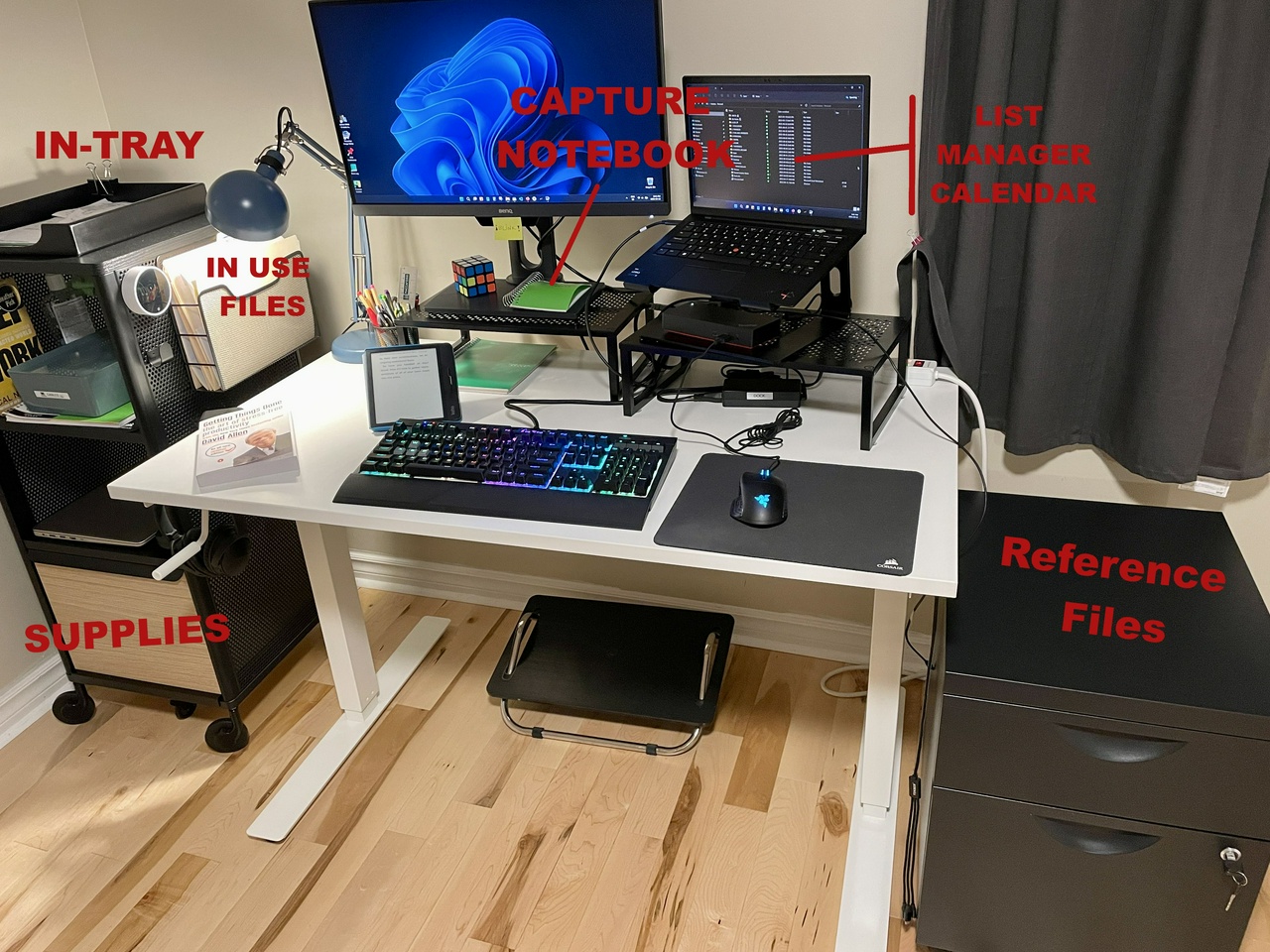GTD Notes: Chapter 04 – Space and Tools
This is a series of posts with reading notes of the book “Getting Things Done: The Art of Stress-Free Productivity” by David Allen.
My notes on Chapter 4 – Getting Started: Setting Up the Time, Space, and Tools
This chapter gives some tips and tricks to get started with the capturing process.
The first thing is to acknowledge that we need time for this. David recommends a weekend or holiday to avoid external disturbances. It will be intense if you're doing it for the first time!
Dedicate two days to this process, and it will be worth many times that in terms of your productivity and mental health. — David Allen
Setting up the space
The second thing to do is to set up a space, in your home and at the office (if you work in one). Have a central space to serve as your “central cockpit of control”, it might be your work office, your home office, any space with the basics:
- a writing surface
- an in-tray
- space for digital tools/computer/laptop if you use one
Also, if we go to an office during work hours, we will still need a space at home. I have a work office (I don't work from home) and a home office, so I have in-trays in both locations.
A side note: I remember when the pandemic started, and I had to work from home during the lockdowns, it was an easy transition. I already had a desk with space for a computer and an office chair at home, while some people really struggled those first months to try to find a space at their homes and set up something. So, thanks, GTD! 👍
Another point is that the space at home doesn't need to be a separate room, it can be a corner where you can fit a desk and a chair to work from. For some years, when I was living in a tiny 1-bedroom apartment, I had my desk on a corner inside the bedroom (right beside my bed!). It worked!
Tools
David Allen then lists what we need to complete the setup: in-trays, stack of plain letter-sized paper, pen/pencil, post-its, paper clips, stapler, scotch tape, rubber bands, an automatic labeller, file folders, a Calendar, wastebasket, devices and notebooks.
From all those items, I think the only one I don't have at all are rubber bands. Oh, I also don't keep a stack of plain paper (I don't have a printer). I use a small spiral notebook as my paper capturing tool. I've only recently acquired a labeller, and it is very satisfying to have things labelled in a nice font. Though I still have to replace my handwritten reference archive labels using my new labeller.
There is a discussion about where to keep the lists. We can do it the “low-tech” way: pieces of paper kept in a folder, or we could go “mid-tech” with loose-leaf notebooks or paper planners, or we can be “high-tech” with our lists in a to-do app. I'm mostly high-tech for my lists: I use a digital calendar and an app (Nirvana).
“Keep in mind, though, that the tool you use will not give you stress-free productivity. That is something you create by implementing the GTD method.” — David Allen
Filing System
Non-actionable but potentially relevant material should be organized in a general-reference file system. These files are: articles, brochures, notes, printouts, manuals, documents, membership cards, etc. Having a dedicated space to store those items avoids the uncertainty and anxiety of figuring out where to store them. If they don't have a home, they will start accumulating in horizontal surfaces, creating clutter and “psychological noise”.
The filing system has to be easy, fast and fun to use. It's also good to make sure we are not storing unnecessary duplicates (a hard copy of something we only access though the Web, for example).
“In the fire zone of real work, if it takes longer than sixty seconds to file something where it belongs, you won't file, you'll “stack.” — David Allen
David recommends using one A to Z alphabetical physical filing system. For the digital systems, he also recommends the A-Z approach.
My physical references are sorted alphabetically, as recommended. But my digital files have always been organized in major “life topics”. I don't know why or how, but I came up with these folders way before I knew what GTD was. I still have them more or less unchanged for 12+ years:
- 1 Education
- 2 Finances
- 3 Fun and Interests
- 4 Personal
- 5 Work
- 6 Home
- 7 Reference
- 8 Photos Archive
The last good practice is to purge our files (digital and physical) at least one a year. I usually take a look at my physical files and recycle some things that are longer current or useful. I have a very small file storage drawer, and I like to keep most of my paperwork in digital form anyway.
Now, I never really purge my digital files because I don't have the issue of lack of storage. I focus on keeping things organized in their folders, and that's enough for me.
My Space at Home
Here is my setup at home:

I'm happy with my space, it has everything I need close at hand. For some years (in the tiny apartment) I didn't have the storage space on the left, so my in-tray was on top the file drawer cabinet on the right.
The next chapter is about capturing stuff. So after we have a space set up, we can start with Step 1: Capture.
-- Post 32/100 of 100DaysToOffload challenge! #100DaysToOffload #100Days #productivity #GTD #GTDnotes
Thoughts? Discuss... if you have a Write.as account or Reply by email
By Noisy Deadlines Minimalist in progress, nerdy, introvert, skeptic. I don't leave without my e-reader.

 Cleanup: Before (left) and after (right)
Cleanup: Before (left) and after (right)